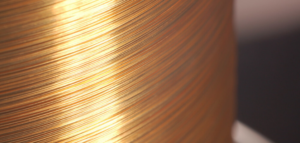The Benefits of Tungsten Probes for Testing Applications
Probing is a broad industry with many types of applications, but two that have proven to be ideal for tungsten wire are:
- Wafer probes used for semiconductor wafer testing
- Neural probes for testing activity in the brain
What properties of tungsten wire make it a great material for these very different probing applications? For the purpose of probe blanks, straightness is a key property — and here, the mechanical properties of tungsten give it remarkable stiffness, even at small diameters.
That neatly sums up the benefits of tungsten wire for both wafer probes and neural testing probes — applications that seem almost counterintuitive for tungsten because it is not a highly conductive material. Yet, for these applications, tungsten probes simply work.
Cantilever Wafer Probes for Integrated Circuit Testing
In the process of fabricating semiconductor devices, there is no better time to test an integrated circuit than when it is on the monocrystalline silicon wafer. This is before the individual circuits are sliced, diced, and packaged — and before the costs associated with all of those activities are incurred.
Semiconductor manufacturing is divided into two distinct stages: the front end, where tungsten plays various roles, and the back end.
The front end is where the boule is cut into wafers and those wafers go through deposition, photolithography, ion implantation, and other processes. This yields an array of integrated circuits printed onto the surface of the wafer.
At this point, tungsten has already facilitated the pulling of the ingot and been used for ion plantation of the wafer. Now tungsten will be used to determine which of the chips is defective, at the conclusion of the front end of wafer fabrication.
The testing of every chip, which is known as the wafer probe test, has evolved into three distinct methods. The first, and still prevalent, is known as cantilever probe testing.
Here, a complex construction of wires radiate out from, and above, the positioning of the four sides of a chip (hence the name “cantilever” for the necessary geometry) — presenting tiny contact patches at the end of each wire to perform a signal test known as a touchdown.
Advantages of Tungsten Wire for Wafer Probes
Several considerations took manufacturers inexorably toward using tungsten wire as the probe “needle” of choice:
- The stiffness needed for positional accuracy
- No springback, so that the bend in the wire remains precisely above the chip
- The ability for the wire to maintain its properties at ever-smaller diameters as chips grew in density
Additionally, since the wire needs to scrub through an oxide layer with every touchdown, probe card manufacturers came to realize they needed to include a probe-cleaning step in their automated systems. Toughness and the ability to penetrate the oxide layer to get a signal make tungsten ideal for this application.
Improved Testing with Rhenium Tungsten
It was here that, in a quirk of industrial history, rhenium tungsten wire solved an emerging problem in cantilever probe test yields. This wire was first developed in the 1920s, when it showed higher ductility and proved useful for its mechanical shock resistance in lamp filaments for lighting needs in harsh environments.
Acting as a probe needle, tungsten — with its elongated grain structure — pierces the oxide layer to enable signal test of the integrated circuit. However, the tungsten probe becomes “loaded” with that very same oxide, and the cleaning sequence for certain probing applications becomes relatively less efficient.
It was discovered that the rhenium content would reside between the tungsten grains without any loss of durability. Therefore, the use of rhenium tungsten wire offers benefits including:
- Less refuge for the oxide to become trapped
- Less cross-signaling
- More effective and less frequent cleaning steps
The Resilience of Tungsten for Wafer Testing
Over time, tungsten ceded some of its dominance to other materials. Since conductivity is paramount when seeking a minute electrical signal, plating and alloying solutions involving softer metals such as copper, gold and palladium have been used when positional accuracy was possible for certain geometries.
Methods known as cobra probing and micro spring probing were developed that could better handle the exponential growth in chip densities and resulting tight pitches. These competing wafer probe systems are more expensive, but they can accomplish the necessary final front end stage on many of the most complex chips requiring the densest pitches.
However, cantilever wafer probing continues to be an enduring and widely used technology for the integrated circuits that power a range of smart devices with pitches that benefit from tungsten wire’s unique properties.
Benefits of Tungsten Wire for Neural Test Probes
We talk elsewhere about some of the properties that make tungsten wire valuable in medical device applications where electric current is utilized and precision is critical.
For example, the high density of tungsten wire makes it highly radiopaque, allowing it to excel in applications such as fluoroscopy. In addition, the high tensile strength of tungsten wire makes it a cost-effective alternative to specialty metals for steerable guide wires in minimally invasive medical procedures.
As the ability to go deeper into the human body has increased, so too has the ability to go deeper into the human brain — and it is here where another important application for tungsten wire is found: probes for testing neural activity.
For the purpose of probing to find causal areas for medical conditions, the ability to target a very specific area of the brain is crucial. Part of the success of tungsten wire in neural probes is due to the ability to go to exact spots within the brain tissue without causing collateral damage.
Neurological probing is a varied field of research and clinical application, spanning deep brain stimulation (DBS), pain management, and a myriad of other applications. But they all rely on positional accuracy, and tungsten wire plays its role to assist scientists and doctors in achieving treatment outcomes and experimental breakthroughs.
This is very much a function of the fact that tungsten wire probes can be made very thin while maintaining their straightness and shape — characteristics that are vital for directional accuracy.
Neural Probes for Stimulation Applications
The same is true of using DBS treatment for conditions such as Parkinson’s disease and peripheral nerve stimulation (PNS) for relief of both chronic and acute pain. Despite not being a highly conductive material, tungsten wire is valuable for the purposes of brain and nerve stimulation therapies in addition to neural probing.
For these and similar applications, tungsten wire has characteristics that are vital for directional accuracy — far more than any other metal. Where the diameter of the wire must be incredibly small and narrow, tungsten wire also maintains its straightness and shape even at tiny diameters and long lengths.
What’s next for tungsten wire?
With all of its interesting properties, it’s no wonder tungsten wire is used in a growing range of applications in both electronics and medicine, as well as in general industry.
Experienced providers of tungsten wire — such as Metal Cutting Corporation, which has been in the specialty tungsten products business since 1967 and is the exclusive North American distributor for Nippon Tungsten Co., Ltd. — can help you decide whether tungsten wire is right for your application.
To learn more about tungsten wire and its viability in probes and other products, download our free guide to tungsten wire properties and applications.






